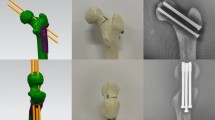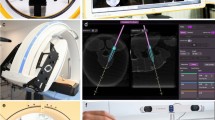Abstract
Introduction
Percutaneous screws placed into the posterosuperior femoral neck are frequently extraosseous or “in–out–in” (IOI). These IOI screws are not readily identifiable on anteroposterior (AP) and lateral fluoroscopic images. The purpose of this study was to examine the ability of surgeons to identify IOI guide pins using sequential fluoroscopic rollover images.
Materials and methods
A 3.2-mm guide pin was placed into the posterosuperior quadrant of eleven synthetic femur models. Five samples were “all-in” (AI), and six were IOI. Sequential fluoroscopic rollover images were obtained starting with an AP image, then images at 10-degree rollover intervals ending with a direct lateral image. Images were reviewed in a blinded fashion by five attending orthopedic trauma surgeons and 20 resident surgeons to determine whether guide pins were AI or IOI. Accuracy, interobserver reliability, sensitivity, and specificity were assessed.
Results
The overall accuracy of responses was 86% with no difference between attending trauma surgeons and residents (p = 0.5). The sensitivity and specificity for an IOI guide pin were 98.0% and 71.2%, respectively. Interobserver reliability among surgeons was good (κ = 0.703).
Conclusion
The use of the sequential fluoroscopic rollover images after placement of the posterosuperior guide pin into the femoral neck was highly sensitive for detecting an IOI position. The 40-degree rollover image was the best view to evaluate the proximity of the guide pin to the posterior cortex.




Similar content being viewed by others
References
Chiu FY, Lo WH, Yu CT et al (1996) Percutaneous pinning in undisplaced subcapital femoral neck fractures. Injury 27(1):53–55
Rogmark C, Flensburg L, Fredin H (2009) Undisplaced femoral neck fractures–no problems? A consecutive study of 224 patients treated with internal fixation. Injury 40(3):274–276
Shehata MSA, Aboelnas MM, Abdulkarim AN et al (2019) Sliding hip screws versus cancellous screws for femoral neck fractures: a systematic review and meta-analysis. Eur J Orthop Surg Traumatol 29:1383–1393
Selvan VT, Oakley MJ, Rangan A et al (2004) Optimum configuration of cannulated hip screws for the fixation of intracapsular hip fractures: a biomechanical study. Injury 35(2):136–141
Zdero R, Keast-Butler O, Schemitsch EH (2010) A biomechanical comparison of two triple-screw methods for femoral neck fracture fixation in a synthetic bone model. J Trauma 69(6):1537–1544
Hoffmann JC, Kellam J, Kumaravel M et al (2019) Is the cranial and posterior screw of the “Inverted Triangle” configuration for femoral neck fractures safe? J Orthop Trauma 33(7):331–334
Gautier E, Ganz K, Krugel N et al (2008) Anatomy of the medial femoral circumflex artery and its surgical implications. J Bone Jt Surg—Ser B 82(5):679–683
Huang T-W, Hsu W-H, Peng K-T et al (2011) Effect of integrity of the posterior cortex in displaced femoral neck fractures on outcome after surgical fixation in young adults. Injury 42(2):217–222
Yang JJ, Lin LC, Chao KH et al (2013) Risk factors for nonunion in patients with intracapsular femoral neck fractures treated with three cannulated screws placed in either a triangle or an inverted triangle configuration. J Bone Jt Surg—Ser A 95(1):61–69
Buderer NMF (1996) Statistical methodology: I. Incorporating the prevalence of disease into the sample size calculation for sensitivity and specificity. Acad Emerg Med 3(9):895–900
Acknowledgements
Study was performed through the Department of Orthopaedic Surgery, Mayo Clinic, Rochester, MN.
Funding
This research did not receive any specific grant from funding agencies in the public, commercial, or not-for-profit sectors.
Author information
Authors and Affiliations
Corresponding author
Ethics declarations
Conflict of interest
None of the authors have financial conflicts of interest relevant to the content of this study.
Additional information
Publisher's Note
Springer Nature remains neutral with regard to jurisdictional claims in published maps and institutional affiliations.
Rights and permissions
About this article
Cite this article
Aibinder, W.R., Yuan, B.J., Cross, W.W. et al. Sequential fluoroscopic rollover images reliably identify “in–out–in” posterosuperior screws during percutaneous fixation of femoral neck fractures. Eur J Orthop Surg Traumatol 30, 1061–1065 (2020). https://doi.org/10.1007/s00590-020-02668-5
Received:
Accepted:
Published:
Issue Date:
DOI: https://doi.org/10.1007/s00590-020-02668-5




